Sitting precariously on the first floor railing, Giang Hoa Xinh, 6 years old, opened a lunch box with white rice and a piece of potato chips.
Hoa Xinh, Mong ethnic group, is a student of class 1A1, Tung Qua Lin Primary and Secondary Boarding School, Phong Tho district, Lai Chau province.
Her house is half a hill away, and it takes her more than 40 minutes to walk each time, so Xinh brings her lunch to school. Most days, she only has white rice, with a spicy stick, or chips as her students Tung Qua Lin call them. Every time she takes a bite of rice, Xinh sucks on the spicy stick to add more flavor. The girl, who is nearly 1 meter tall and weighs 15 kg, eats heartily, occasionally laughing shyly at her "simple menu" when a friend runs by.
About 10 meters away from Xinh, Giang A Chinh, class 2A1, squatted in the corner of the hallway, also eating white rice and stir-fried pumpkin. With a spoon in each hand, Chinh ate rice continuously, occasionally wiping his nose.
In the teachers’ temporary housing area, about 10 students were huddled together to make instant noodles from a pot. These were students who had no lunch, or only had white rice, so their homeroom teacher helped them cook noodles with eggs.
"Sometimes students ask teachers to boil water to pour over rice, but I can't bear to do so, so I cook instant noodles for them," said Mr. Dong Van Phong, homeroom teacher of class 5A2.
Teacher Phong said that the cost of instant noodles and eggs for each meal for his students is about 50,000 VND, sometimes more, so the average fluctuates between 1.5-2 million VND per month.
"There is no individual or organization that supports this, so if teachers love their students, they should join hands to help them," said Mr. Phong, handing out bowls and chopsticks for students to get noodles.
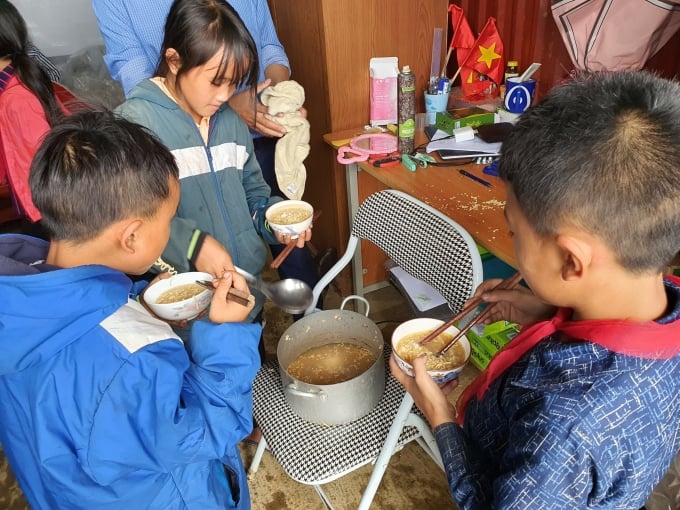
Students take noodles and eggs and eat standing up. Photo: Thanh Hang.
Tung Qua Lin Primary and Secondary Boarding School for Ethnic Minorities is located in the commune of the same name. Located between the high mountains of the Vietnam - China border, Tung Qua Lin is one of the particularly difficult communes of Phong Tho district. Most of the students at the school are Mong ethnic people, with a small number of Ha Nhi people.
Ms. Cu Thi Lan Huong, principal, said that about a third of the more than 380 elementary school students bring their lunch and stay at school at noon. But having meat for lunch is a luxury for them. The popular menu is pumpkin, stir-fried radish, dried fish; many students eat white rice with spicy food like Xinh or with boiling water. Once, Ms. Huong caught students eating rice with rat meat. They often eat lunch "each in a corner", afraid to let their friends see their "unmanned" lunch boxes.
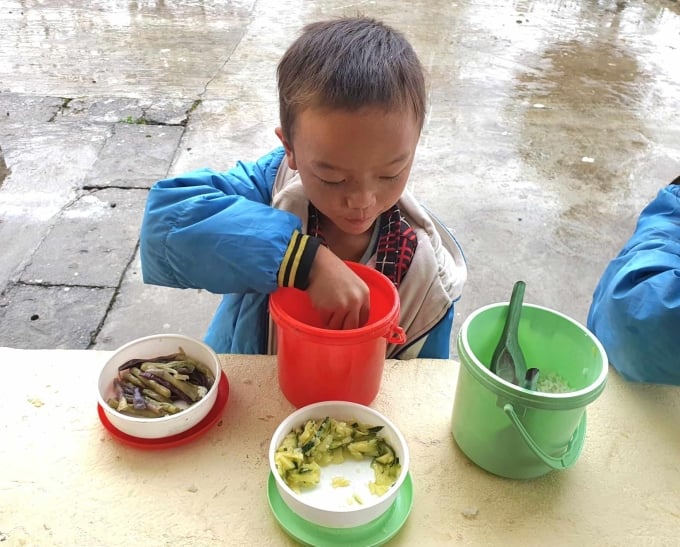
Meatless lunch of Tung Qua Lin students. Photo: Thanh Hang.
Before the 2019-2020 school year, most Tung Qua Lin students were eligible for boarding meals and accommodation at school. According to Decree 116/2016 of the Government on support policies for students, primary schools in extremely disadvantaged communes, primary school students are entitled to boarding if their houses are located 4 km from the school. Every month, they are supported with 40% of the basic salary, equivalent to 720,000 VND (from July 1 this year) and 15 kg of rice.
Since the concrete road connecting Ho Meo village, located at the foot of the mountain, to Tung Qua Lin school at the top of the mountain was completed, the distance from home to school has been shortened. No student lives more than 4 km from school, which means they no longer receive boarding support.
Therefore, students either walk home at noon and continue walking to school in the afternoon, or bring lunch from the morning and stay at school.
Ms. Huong said that no teacher wants students to choose the first option. Although the route is shortened, this distance is very difficult to travel because of the steep slope. Most of the students are Mong - an ethnic group that still has a habit of incestuous marriage, so they are small. A 5th grader usually weighs only about 20 kg and is over 1 meter tall. Therefore, it takes them nearly an hour to travel 2 km of steep road.
"If they walk home at noon and go to school in the afternoon, they don't have enough time to rest. Many children are tired and lazy, and if they come home at noon, they don't go to school in the afternoon," said Ms. Huong.
According to the principal, sunny days are “tolerable”, but when it rains, the roads are slippery, making it dangerous for students to go up or down the mountain. When winter comes, the weather is bitterly cold, and the students will come to class with their heads soaked with dew, barefoot and shivering.
Tung Qua Lin students' way to school. Video: Thanh Hang
Impatient with this reality, the leaders of Tung Qua Lin commune have repeatedly petitioned for students here to enjoy the meal and boarding regime according to Decree 116.
"Every year we make recommendations, sometimes to the provincial delegation, sometimes during voter meetings, but we have never received a response," said Mr. Ma A Ga, Vice Chairman of Tung Qua Lin Commune.
According to the commune leader, the policy should be applied according to the practical conditions of each locality. Mr. Ga commented that students in mountainous areas all walk, the 2 km distance "sounds close", but it is a steep slope so it is very difficult. Not to mention that in the long run, inadequate nutrition will affect the physical and intellectual development of an entire generation.
"I just hope students can soon have lunch at school," Mr. Ga said.
Hoa Xinh, A Chinh and 380 other elementary school students were unaware of the policy changes. They still carried their lunch boxes and walked to school every day.
Every meal, she eats all the rice, but when asked "is it delicious", Xinh mumbles "I like to eat it with eggs, or vegetables".
To further motivate children in the highlands to have the opportunity to improve their lives, the Hope Fund – VnExpress newspaper continues to accept donations in the School Light program. Each contribution from readers is another ray of light sent to the future generation. Readers can see information about the program here.
Thanh Hang
Source link


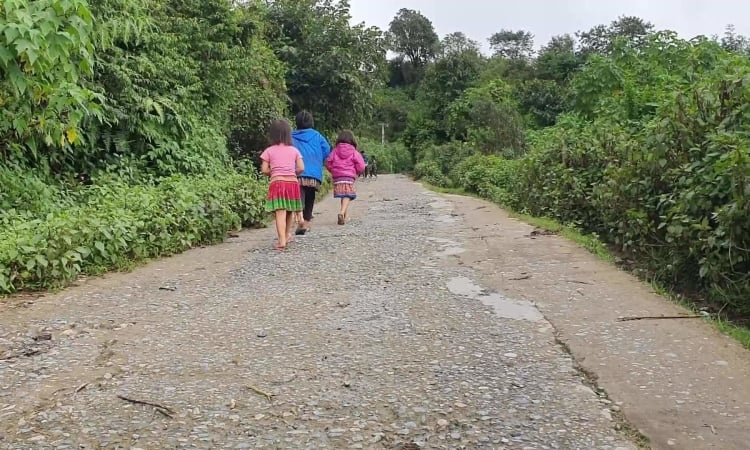


![[Photo] "Beauties" participate in the parade rehearsal at Bien Hoa airport](https://vstatic.vietnam.vn/vietnam/resource/IMAGE/2025/4/11/155502af3384431e918de0e2e585d13a)


![[Photo] Looking back at the impressive moments of the Vietnamese rescue team in Myanmar](https://vstatic.vietnam.vn/vietnam/resource/IMAGE/2025/4/11/5623ca902a934e19b604c718265249d0)
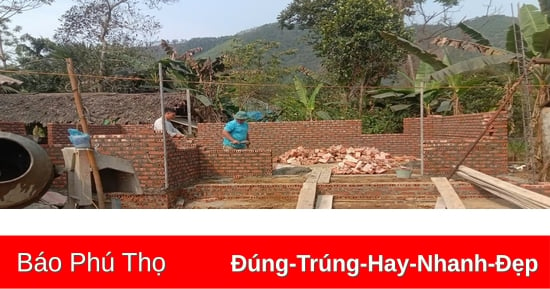







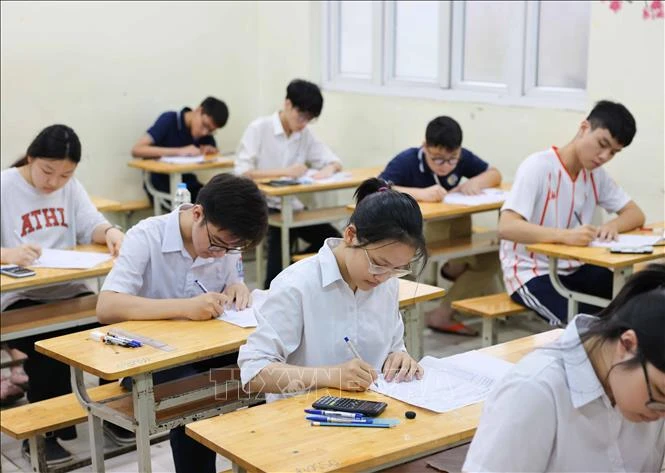
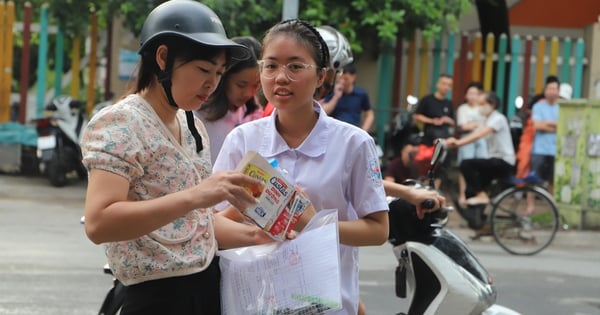
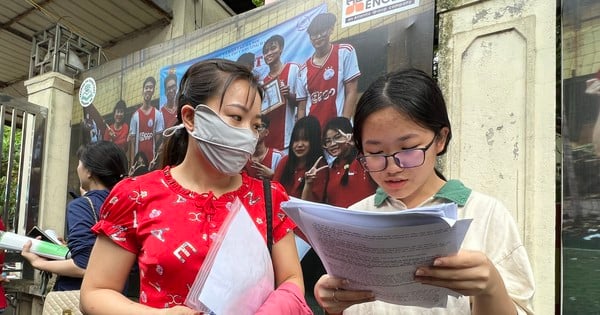
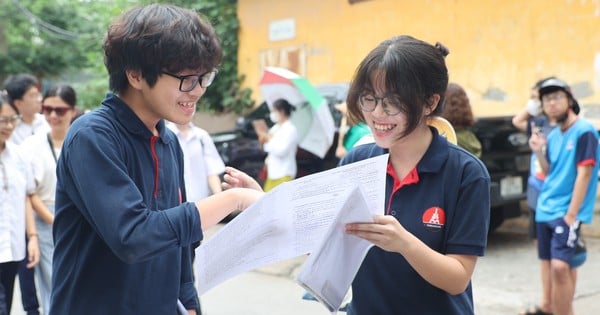
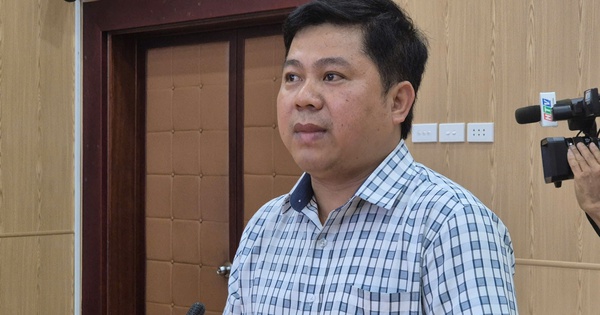
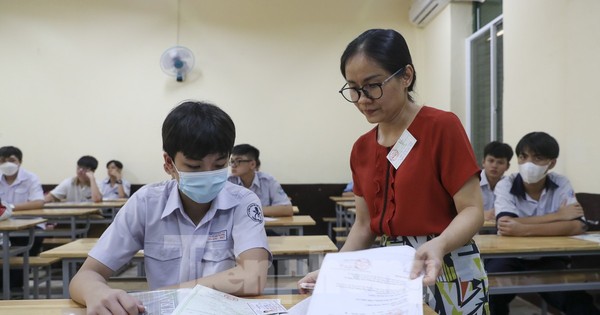








![[Photo] Summary of parade practice in preparation for the April 30th celebration](https://vstatic.vietnam.vn/vietnam/resource/IMAGE/2025/4/11/78cfee0f2cc045b387ff1a4362b5950f)






































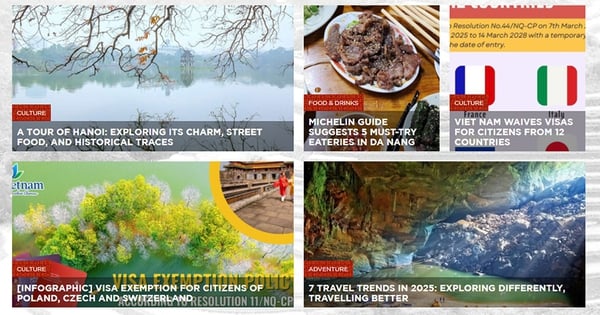


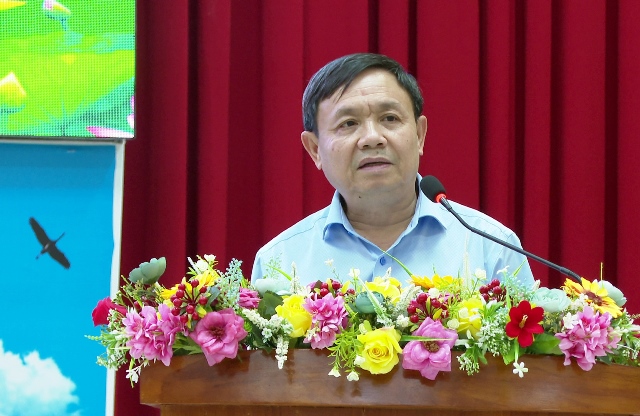
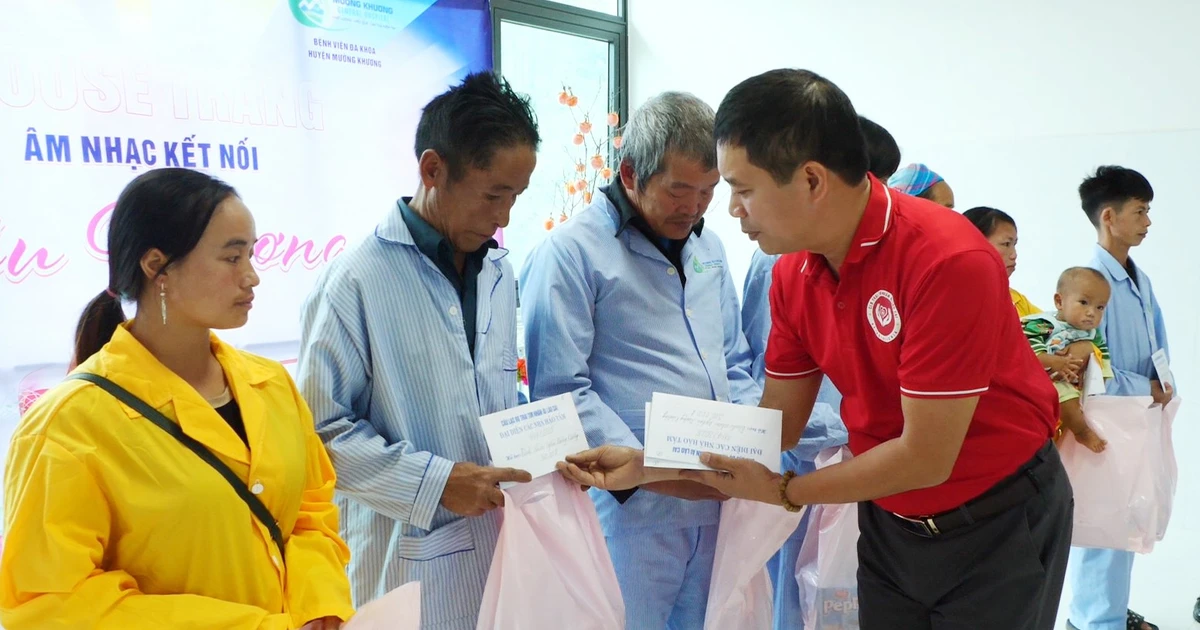

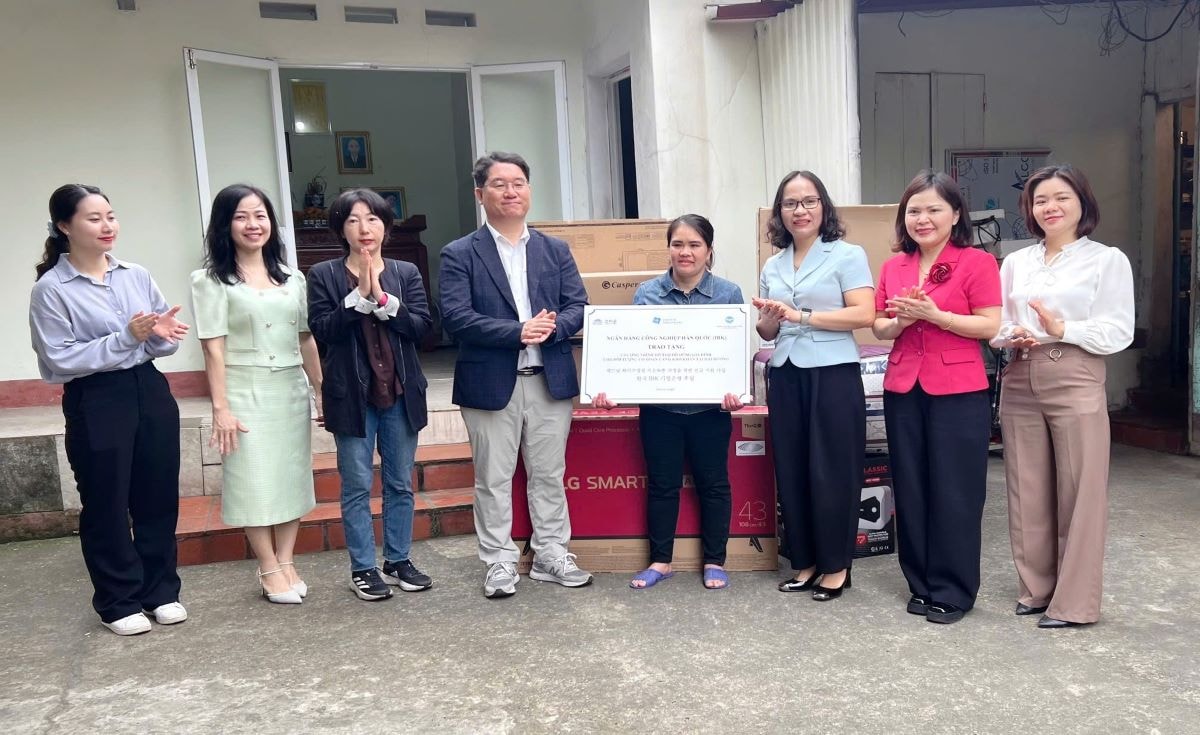

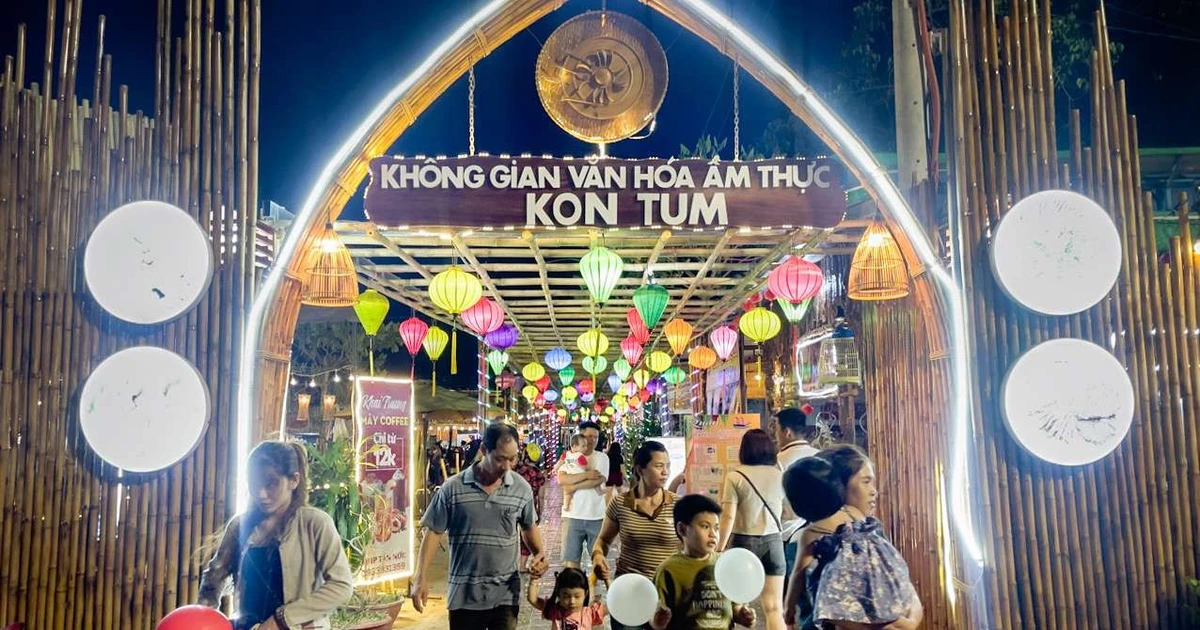














Comment (0)